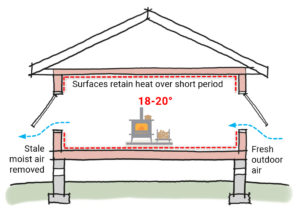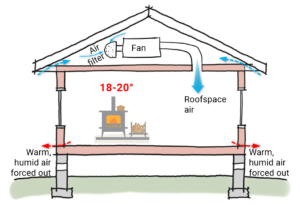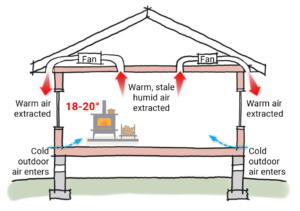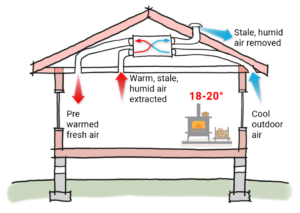The purpose of ventilation is to provide fresh air to a room or, a building, for you to breathe.
VENTILATION
WHY must we ventilate?
Ventilation serves one primary purpose which is to provide good Indoor Air Quality for us to breath. Since we spend more than 90% of our lives inside buildings, this is important for our respiratory health. But there are other benefits too.
Adequate ventilation should:
- Remove harmful contaminants (ie fine particles, and organic chemicals from cooking & carbon monoxide and nitrogen dioxide if using a gas hob)
- Remove excess moisture (generated from household activities such as cooking, showering and even breathing. The average family can produce eight litres per day).
- Remove carbon dioxide
- Introduce oxygenated fresh air from outside (not a dusty old roof space)
- Replace at least35% of the internal volume of air every hour (NZS4304 the standard for Ventilation for acceptable indoor air quality)
Natural ventilation

If you live in a home with out mechanical ventilation, then opening windows and doors are how you can ventilate for free. Blast ventilation is the most efficient method of naturally ventilating by opening all windows and doors for a short period (5-10 minutes). This reduces heat losses as the surfaces inside the home will retain heat even after the air is replaced.
– Open up windows and doors throughout the home. For best results use cross-ventilation (opening two windows at a time to increase the airflow). If there is a breeze this should introduce a strong breeze through the home.
– Leave the house open for 5-10 minutes.
– Get in the habit of ventilating twice a day, morning & night (once in the middle of the day in winter is okay).
Extraction at the source
Extractor fans and range hoods are a decentralised form of negative pressure ventilation commonly found in kitchens and bathrooms. These are a requirement to comply with the Building Code and the Healthy Homes Standard in New Zealand.
TIPS
-Select an extract fan that has a draft excluding features to prevent unwanted drafts, this is especially important when installing thru wall extractors. Also if avoidable do not install facing the prevailing wind.
-Select a more powerful fan than needed (most heat/lamp/fan combos are too weak).
-Ensure the fan vents to the outside of the building and not into the roof space
-Complex ducting reduces the efficiency of the system. Aim for the shortest route to exhaust outside.
For best results turn on the extraction fan before you start your shower/bath/cooking, and leave a window slightly open to draw in ‘make-up’ air to increase its effectiveness. Also leave the fan running for at least 15 minutes afterwards to remove residual moisture. This can be easily achieved by installing a fan timer or a humidity sensor to ensure the moisture is adequately removed. Extract fans need to be cleaned regularly to maintain their effectiveness.
Mechanical ventilation systems
In New Zealand’s temperate climate, opening windows has always been thought to provide most of the ventilation we need. However this view is fast becoming a thing of the past, many moving towards mechanical ventilation to ensure good indoor air quality. Many other OECD countries now require mechanical ventilation systems as a minimum. There are many systems available, and they perform indifferent ways. In all cases careful design and consideration is vital to ensuring they achieve good indoor air quality. For tailored impartial advice speak to your local Eco Design Advisor.
Ventilation distribution
Centralised ventilation systems use a duct network to transport the supply and extract air.
Decentralised systems, rely on numerous devices usually placed directly in the external walls of the building.
Positive Pressure

Sold by HRV, DVS, Unovent, Smartvent, Reliance, Etc
Since the early 2000’s there have been positive pressure ventialtion (PPV) systems marketed in New Zealand. Typically taking air from the roof space, which is then (hopefully) filtered and fan forced into the living spaces. As a result this forces warm indoor air out through gaps and cracks in the building.
Note: Ventilation systems that do not bring in fresh air from outside do not comply with NZS4304 the standard for Ventilation for acceptable indoor air quality. In addition there are many instances where a PPV systems can cause unintended moisture problems so it is important to consider this option carefully.
If you have an existing PPV system they can be easily modified with ducting to introduce fresh air from outside. To ensure pollens and fine particles are removed from the air, add a F7 or equivalent fine particle filter.
Negative Pressure

Negative pressure ventilation is a fan or series of fans continuously extracting humid air from wet areas (bathrooms, kitchens and laundries). This causes ‘fresh’ make up air to be sucked in through gaps and cracks in the building. The fans should have at least two speeds to allow high speed extraction when showering or cooking. This is the cheapest effective option however there is incoming ‘make up’ air is coming from unknown sources and cannot be filtered.
Balanced Pressure

AKA Mechanical Ventilation with Heat Recovery (MVHR)
Balanced pressure ventilation (BPV) systems work by pulling in fresh air from outside while extracting the stale humid air at the same time. They usually incorporate a Heat Exchanger which pre warms the in-coming air. These systems are best suited to new homes that are more airtight – however they still provide benefits for older homes too.
Typically a BPV system is introducing fresh outdoor air which is filtered removing pollens and other contaminants ensuring high Indoor Air Quality. A BPV systems can recover heat from out-going air at an efficiency of up to 95%. They can also incorporate an exhaust boost function to also provide local moisture removal. There are also decentralised options available where no roof cavity is available.
DOWNLOAD PDF